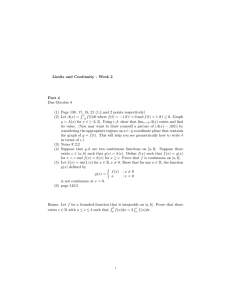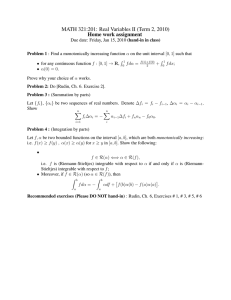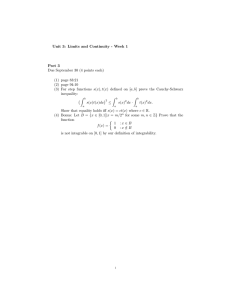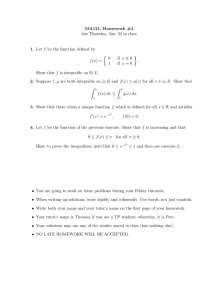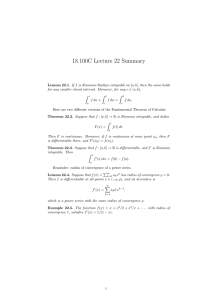Problem Set 10 Solutions, 18.100C, Fall 2012 1 5, 2012
advertisement
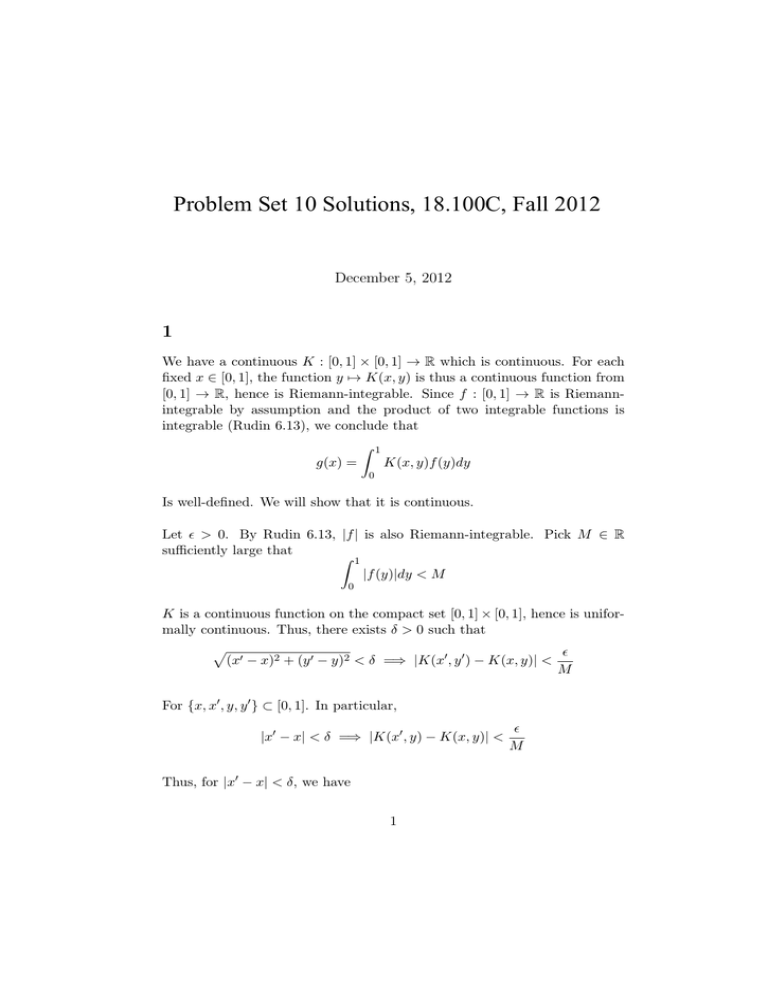
Problem Set 10 Solutions, 18.100C, Fall 2012
December 5, 2012
1
We have a continuous K : [0, 1] × [0, 1] → R which is continuous. For each
fixed x ∈ [0, 1], the function y → K(x, y) is thus a continuous function from
[0, 1] → R, hence is Riemann-integrable. Since f : [0, 1] → R is Riemann­
integrable by assumption and the product of two integrable functions is
integrable (Rudin 6.13), we conclude that
1
g(x) =
K(x, y)f (y)dy
0
Is well-defined. We will show that it is continuous.
Let E > 0. By Rudin 6.13, |f | is also Riemann-integrable. Pick M ∈ R
sufficiently large that
1
|f (y)|dy < M
0
K is a continuous function on the compact set [0, 1] × [0, 1], hence is unifor­
mally continuous. Thus, there exists δ > 0 such that
(x' − x)2 + (y ' − y)2 < δ =⇒ |K(x' , y ' ) − K(x, y)| <
For {x, x' , y, y ' } ⊂ [0, 1]. In particular,
|x' − x| < δ =⇒ |K(x' , y) − K(x, y)| <
Thus, for |x' − x| < δ, we have
1
E
M
E
M
Z
|g(x ) − g(x)| = 0
1
1
Z
0
K(x , y)f (y)dy −
0
0
K(x, y)f (y)dy Z 1
Z
0
= (K(x , y) − K(x, y))f (y)dy ≤ |K(x0 , y) − K(x, y)| · |f (y)|dy
0
Z 1
<
|f (y)|dy < M 0
Which proves the (uniform) continuity of g.
2
Let a, b ∈ R. I claim that max(a, b) = (a+b+|a−b|)/2. There are three cases.
a = b: Then (a + b + |a − b|)/2 = a =max(a, b).
a > b: Then (a + b + |a − b|)/2 = (a + b + a − b)/2 = a =max(a, b).
a < b: Then (a + b + |a − b|)/2 = (a + b + b − a)/2 = b =max(a, b).
Now suppose f and g are Riemann-Stieltjes integrable for some α. Then
f −g is integrable, hence so is |f −g|, hence so is (f +g+|f −g|)/2 =max(f, g).
3
a
Suppose f : [a, b] → R is continuous. Then by theorem 6.8, f 2 ∈ R. By
assumption there exists x0 ∈ [a, b] with f (x0 ) 6= 0. Because f 2 is continuous
at x0 there exists a δ > 0 such that
x ∈ [a, b], |x − x0 | < δ =⇒ |f 2 (x) − f 2 (x0 )| < |f 2 (x0 )|/2.
Thus
x ∈ [a, b], |x − x0 | < δ =⇒ |f 2 (x)| > |f 2 (x0 )|/2.
By definition
Z
b
2
2
2
f (x)dx = sup L(P, f ) and L(P, f ) =
a
n
X
i=1
2
mi ∆xi .
If we choose a partition P with two points in [a, b] ∩ (x0 − δ, x0 + δ) then at
least one of the mi ’s is strictly greater than zero and the rest are all greater
than or equal to zero. Thus for this partition L(P, f ) > 0 and we obtain
f 2 > 0.
b
1
Let f : [0, 1] → R be continuous and suppose that 0 xn f (x)dx = 0 for all
1
n ∈ N. From linearity of the integral we deduce that 0 p(x)f (x)dx = 0 for
all polynomials p. Weierstrass’ theorem says that we can find a sequence
of polynomials (pn ) converging uniformly to f . Since f is bounded (pn f )
converges uniformly to f 2 . Then
Z 1
Z 1
f (x)2 dx
pn (x)f (x)dx →
0
0
1
giving 0 f (x)2 dx = 0. Since f 2 is positive and continuous this implies that
f 2 = 0 and so f = 0.
3
MIT OpenCourseWare
http://ocw.mit.edu
18.100C Real Analysis
Fall 2012
For information about citing these materials or our Terms of Use, visit: http://ocw.mit.edu/terms.


![Problem Set 10 f : [0, 1] →](http://s2.studylib.net/store/data/013569988_1-b32f052245a733a21bc2676ade2326f2-300x300.png)
